Did you know that up to 95% of people get acne during their teens1? Hormonal acne causes oily skin, spots, and pimples on the face and upper body. It can hit anyone, not just teens, due to hormonal shifts from menstruation, menopause, or stress. I’ve dealt with hormonal acne myself and know how it can knock your confidence. But there’s a light at the end of the tunnel! In this article, we’ll look into if patches can treat hormonal acne and share effective solutions.
Pimple patches are becoming more popular, thanks to COVID masks and the self-care trend2. These patches are meant for one-time use and usually come in packs of up to 152. But do they really help with hormonal acne? Research shows hydrocolloid patches are better than traditional coverings for wounds and acne1. They outperform other non-hydrocolloid patches in studies1.
While pimple patches can reduce inflammation and target specific pimples2, they have their limits. Patches with tea tree oil might make pimples come back because they don’t draw out fluid1. They can also dry out or irritate sensitive skin1. Plus, they don’t work on dirt clogged pores, blackheads, whiteheads, or cystic acne1.
So, pimple patches can be a useful tool in fighting hormonal acne, but they’re not the only answer. It’s key to mix lifestyle changes, over-the-counter meds, and medical treatments for the best results. Keep reading to learn more about hormonal acne, traditional treatments, natural remedies, and how to use patches for the best skincare routine.
Key Takeaways
- Hormonal acne affects up to 95% of people during adolescence and can impact adults due to hormonal changes
- Pimple patches, particularly hydrocolloid patches, have been found effective in treating certain types of acne
- Patches have limitations and may not work for all types of acne or skin sensitivities
- A combination of lifestyle changes, medications, and treatments is often needed for effective hormonal acne management
- Understanding the causes, symptoms, and various treatment options can help you find the best solution for your hormonal acne
Understanding Hormonal Acne
Hormonal acne can be really tough to deal with. It’s frustrating and overwhelming. But first, let’s learn what it is, why it happens, and how you can tell if you have it.
What is Hormonal Acne?
Hormonal acne is caused by changes in hormones, like testosterone. These changes make your skin produce more oil. This oil can clog pores and cause pimples, blackheads, and whiteheads. Almost all teens get acne because of these hormonal changes3.
Causes of Hormonal Acne
Hormonal acne is mainly caused by hormone imbalances. This can happen during puberty, menstruation, pregnancy, and menopause. Other things that can make it worse include:
- Genetics
- Stress
- Certain medications (e.g., corticosteroids, lithium, and anticonvulsants)
- Diet (high-glycemic foods, dairy products)
Research shows that many women with hormonal acne have too much testosterone. A 2013 study found that 55% of 835 women had high levels of androgens, with DHEA being the most common4. A Turkish study in 2017 also found that 55% of women with acne had high levels of androgens4.
Symptoms of Hormonal Acne
Hormonal acne usually shows up on the face, especially in the T-zone. This includes the forehead, nose, and chin3. The symptoms can include:
- Whiteheads (closed comedones)
- Blackheads (open comedones)
- Papules (small, red, inflamed bumps)
- Pustules (papules with pus at the tip)
- Nodules and cysts (large, painful, deep-seated lesions)
Hormonal acne can start in your teens and last into your 20’s and 30’s. It can also start during perimenopause and menopause4.
Knowing what kind of acne you have is key to finding the right treatment. If you think you have hormonal acne, talk to a dermatologist or healthcare provider to explore your options.
By understanding hormonal acne definition, hormonal acne causes, and hormonal acne symptoms, you can start managing it. This can help you get clearer, healthier-looking skin.
Traditional Treatments for Hormonal Acne
There are many ways to treat hormonal acne. These methods aim to fix the main causes of hormonal acne, like too much oil, androgens, and bacteria. Acne affects 70 to 87 percent of teens, with most starting treatment around age 245. Women get acne more than men, and it costs over $1 billion a year in the U.S5..

Topical Retinoids
Topical retinoids, like tretinoin and adapalene, are used for mild to moderate acne. They clear pores, reduce swelling, and help skin cells grow. But, they can make skin dry, red, and peel at first. It’s important to keep using them and be patient.
Oral Contraceptives
Birth control pills with ethinyl estradiol and progestin, like drospirenone, can help with hormonal acne. They balance hormones, cut down androgens, and oil6. Studies show they work well for acne7. But, they might not be right for everyone and can have side effects.
Anti-Androgen Drugs
Spironolactone is used for hormonal acne in women. It blocks androgens, which lowers oil and acne7. It can make acne better by 50-100%7. But, it’s not safe during pregnancy and can cause side effects like irregular periods and breast tenderness.
| Treatment | Mechanism of Action | Efficacy |
|---|---|---|
| Topical Retinoids | Unclog pores, reduce inflammation, promote cell turnover | Effective for mild to moderate hormonal acne |
| Oral Contraceptives | Regulate hormone levels, reduce androgen production, decrease sebum production | Positive effect on treating acne in women |
| Anti-Androgen Drugs (Spironolactone) | Block androgen receptors, reduce sebum production | Can reduce acne by 50-100% in women |
Choosing a treatment for hormonal acne needs a doctor’s advice. They consider how bad the acne is, your age, and health history. While these treatments can help, they might not work for everyone. In fact, 81 percent of women don’t get better with antibiotics, and 15 to 30 percent fail with isotretinoin5.
Natural Remedies for Hormonal Acne
If you’re searching for natural ways to fight hormonal acne, you’re not alone. Many adults deal with this skin issue, especially before their period8. While birth control pills can help by lowering androgens, many prefer natural options. Let’s explore some effective natural remedies like tea tree oil, alpha hydroxy acids (AHAs), and green tea.
Tea Tree Oil
Tea tree oil is known for its ability to fight acne due to its antimicrobial properties. A 2019 study showed that it can reduce acne sores9. However, it might irritate sensitive skin10.
Alpha Hydroxy Acid (AHA)
Alpha hydroxy acids (AHAs) are plant acids that help remove dead skin cells and reduce acne scars. A 2012 study found that using clay face masks with jojoba oil improved acne by 54% after 6 weeks9.
| AHA Type | Source | Benefits |
|---|---|---|
| Glycolic Acid | Sugar cane | Exfoliates, reduces fine lines, evens skin tone |
| Lactic Acid | Milk | Gently exfoliates, hydrates, brightens skin |
| Mandelic Acid | Almonds | Mild exfoliation, reduces acne, evens skin tone |
Green Tea
Green tea is packed with polyphenols, which fight inflammation and are antioxidants. A 2017 study found a 79–89% reduction in acne after using green tea extract for 8 weeks9. It can help reduce acne inflammation and lesions.
I’ve been using green tea as a toner for my hormonal acne, and I’ve noticed a significant improvement in my skin’s overall appearance. It’s definitely worth trying if you’re looking for a natural remedy.
Natural remedies can help manage hormonal acne, but lifestyle changes are also key. Exercise can improve acne by boosting circulation and reducing inflammation. Stress can make acne worse8. Also, cutting down on dairy and high glycemic foods like white bread and pasta can help8.
Does the Patch Help Hormonal Acne?
Dealing with acne can be really tough. Over 50 million Americans have it11. Half of all women in their 20s and a third in their 30s get breakouts11. Birth control pills can help, but you might wonder if pimple patches work too. Let’s explore how these patches can help with hormonal acne.
How Pimple Patches Work
Pimple patches are stickers you put on pimples. They soak up oil and dirt, helping pimples heal faster. Some patches have ingredients that fight bacteria and reduce swelling. They also protect pimples from picking and irritation.
Using hydrocolloid patches at night can make pimples smaller and less red by morning. They’re great for whiteheads, preventing scabs and scars.
Types of Pimple Patches
There are many kinds of pimple patches, each with its own benefits:
- Hydrocolloid patches: These absorb moisture and protect pimples. They’re perfect for whiteheads and prevent scarring.
- Medicated acne patches: These patches have ingredients like salicylic acid or benzoyl peroxide. They fight bacteria and reduce swelling, great for red pimples.
- Microneedling acne patches: These patches have tiny spikes that help active ingredients get deep into the skin. They’re good for blind pimples that are hard to treat.
“I’ve tried countless acne treatments over the years, but pimple patches have been a game-changer for me. They’re easy to use, affordable, and most importantly, they work!”
Pimple patches can be a great spot treatment for hormonal acne. But remember, they’re not a complete solution. For real results, you need a full skincare routine, healthy eating, and sometimes medicine. Still, adding pimple patches to your routine can speed up healing and prevent more breakouts.
The Active Ingredients in Pimple Patches
Pimple patches are great for fighting hormonal acne. They have ingredients that kill bacteria, reduce swelling, and help skin heal. Let’s explore some key ingredients in these patches.
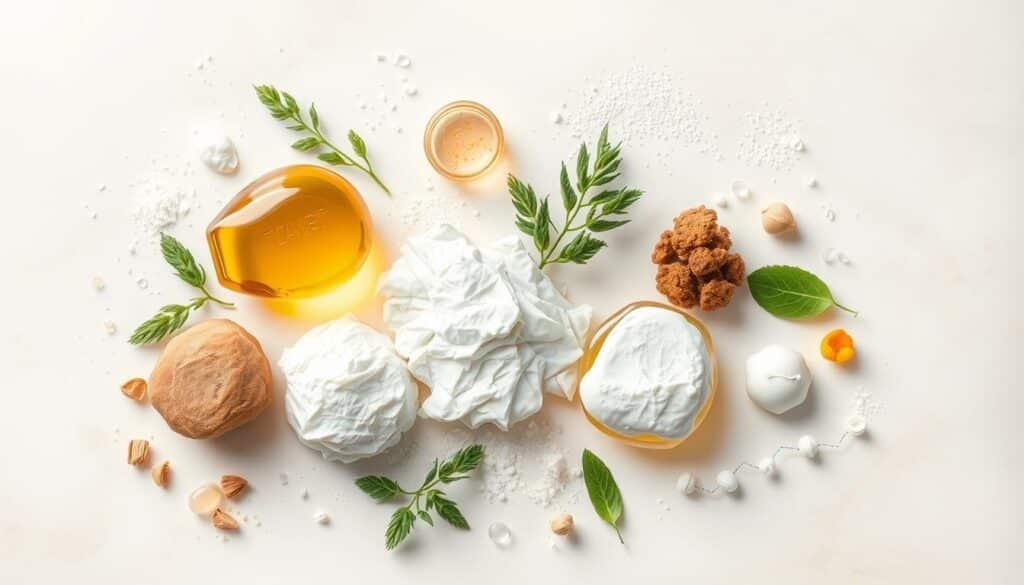
Salicylic Acid
Salicylic acid is a beta-hydroxy acid (BHA) that cleans out pores. It gets deep into pores to clear out oil and dead skin, helping with acne12. Patches with salicylic acid are good for blackheads and stopping new breakouts13. But, it can dry out skin and irritate it, especially for those with sensitive skin.
Tea Tree Oil or Tea Tree Extract
Tea tree oil is known for its antibacterial and anti-inflammatory effects. It kills bacteria that cause acne and reduces redness and swelling12. Patches with tea tree oil can soothe acne symptoms14. Yet, like salicylic acid, it can dry out skin, so use it carefully and moisturize afterward.
Benzoyl Peroxide
Benzoyl peroxide fights bacteria and reduces swelling. It releases oxygen in pores, making them hard for bacteria to live in12. Patches with benzoyl peroxide can tackle severe acne like cystic acne14. But, it can dry out skin, cause peeling, and irritation, so start with a low dose and increase slowly.
| Active Ingredient | Benefits | Considerations |
|---|---|---|
| Salicylic Acid | Unclogs pores, exfoliates skin, treats blackheads | Can be drying and irritating for sensitive skin |
| Tea Tree Oil | Antibacterial, anti-inflammatory, reduces redness | Can be drying, use in moderation |
| Benzoyl Peroxide | Kills bacteria, reduces inflammation, treats cystic acne | Can cause dryness, peeling, and irritation; start with lower concentrations |
When picking a pimple patch for hormonal acne, look for ones with these ingredients to tackle your acne concerns13. Remember, these ingredients can have side effects, so listen to your skin and adjust your use as needed.
Benefits and Limitations of Pimple Patches for Hormonal Acne
Pimple patches are popular for treating acne, but knowing their strengths and weaknesses is key. They work best on open pimples, reducing their size and redness15. They also stop us from picking at pimples and keep the area clean16.
But, pimple patches aren’t for everyone. They’re not good for all types of acne and only help with specific pimples16. They might not work on closed or deeper pimples, blackheads, or whiteheads17. They’re better for pus-filled pimples and blackheads, but not always for cystic acne16.
Pimple patches are spot treatments for active bumps. They don’t prevent acne or clear pores17. They offer temporary relief for some pimples but not for deeper, cystic acne15.
Some people might find pimple patches irritating, especially if they have sensitive skin17. Certain patches include ingredients like salicylic acid or tea tree oil, which can help with acne1615. But, these might not be right for everyone.
| Pimple Patch Benefits | Pimple Patch Limitations |
|---|---|
| Work best on open, draining, healing pustules, papules, and cysts | Generally unhelpful for most people but do not typically worsen acne |
| Create an occlusive barrier, reducing pimple size and redness | May irritate sensitive skin due to adhesive or active ingredients |
| Prevent picking and protect from debris and bacteria | Do not work on closed lesions, deeper lesions, blackheads, whiteheads, or comedones |
| Offer targeted treatment directly on the pimple | Do not prevent acne or clear clogged pores; considered spot treatments only |
Pimple patches can help with some acne, but they’re not a cure-all. Hormonal acne might need special treatments from dermatologists17. Professional treatments can tackle acne at its root and offer lasting solutions15.
Lifestyle Changes to Manage Hormonal Acne
Managing hormonal acne is more than just using treatments or meds. Making lifestyle changes can really help. By setting up a good skincare routine for hormonal acne and changing what you eat, you can control your acne better. This improves your skin health overall.
Establish a Proper Skincare Routine
A consistent skincare routine is key for managing hormonal acne. I wash my face twice a day with a gentle cleanser. I apply acne-fighting products carefully to avoid drying out my skin. And I always wear sunscreen to protect against UV damage.
Choosing non-comedogenic products is also important. This prevents clogged pores, which can make acne worse18.
Here’s a sample skincare routine I follow:
| Step | Product | Frequency |
|---|---|---|
| Cleanse | Gentle, non-foaming cleanser | Twice daily (morning and evening) |
| Treat | Salicylic acid spot treatment or benzoyl peroxide | Once daily (evening) |
| Moisturize | Light, oil-free moisturizer | Twice daily (morning and evening) |
| Protect | Broad-spectrum sunscreen (SPF 30 or higher) | Every morning |
Diet Modifications for Hormonal Acne
While the link between diet and hormonal acne is still being studied, some foods may help. Cutting down on sugar, dairy, and refined carbs has helped me. It reduces inflammation and breakouts18.
Adding omega-3s, antioxidants, zinc, vitamin A, and fiber to my diet has also helped. Foods like fresh fruits, whole grains, lean proteins, and healthy fats are good choices18.
- Fresh fruits and vegetables
- Whole grains like steel-cut oats and quinoa
- Lean proteins such as fish, chicken, and legumes
- Healthy fats from avocados, nuts, and seeds
Making lifestyle changes like reducing stress, getting enough sleep, maintaining a balanced diet, and using non-comedogenic products can help decrease the risk of experiencing hormonal acne19.
By combining a good skincare routine with dietary changes, I’ve managed my hormonal acne better. Everyone’s skin is different. It’s important to find what works for you and get advice from a healthcare provider or dermatologist18.
Conclusion
Managing hormonal acne needs a mix of strategies that fit your skin type and needs. Pimple patches can help with open, pus-filled pimples by soaking up oil and pus and speeding up healing20. But, they might not work as well for blackheads, closed spots, or deep cystic acne20.
It’s key to know that pimple patches only treat acne symptoms, like too much oil, clogged pores, or bacteria20. They don’t fix the main causes of acne.
If you’re looking for more than pimple patches, try lifestyle changes, over-the-counter meds, and medical treatments. Birth control pills can help with persistent acne or oily skin that doesn’t get better with other treatments21. But, they can cause side effects like nausea, headaches, and mood swings21.
Always talk to a dermatologist to find the best treatment for you. They can guide you through the options and help you find what works best for your skin. Getting clear, healthy skin takes time, patience, and a good skincare routine.
FAQ
What is hormonal acne?
What are the different types of acne?
What are the traditional treatments for hormonal acne?
Can natural remedies help treat hormonal acne?
How do pimple patches work?
What are the benefits and limitations of using pimple patches for hormonal acne?
What lifestyle changes can help manage hormonal acne?
Source Links
- What Are Hydrocolloid Patches for Pimples? – https://www.webmd.com/skin-problems-and-treatments/acne/what-are-hydrocolloid-patches-for-pimples
- Pimple Patches and What They Offer – American Chemical Society – https://www.acs.org/education/chemmatters/articles/pimple-patches-and-what-they-offer.html
- Treatments and Natural Remedies for Hormonal Acne – https://www.healthline.com/health/beauty-skin-care/hormonal-acne
- Hormonal acne & cystic acne – Best treatments | Dr Sajjad Rajpar – https://www.midlandskin.co.uk/hormonal-acne/
- Hormonal Treatment of Acne in Women – https://www.ncbi.nlm.nih.gov/pmc/articles/PMC2923944/
- Hormonal treatment of acne vulgaris: an update – https://www.ncbi.nlm.nih.gov/pmc/articles/PMC5015761/
- How To Treat Hormonal Acne: A Comprehensive Guide – https://www.pandiahealth.com/blog/how-to-treat-hormonal-acne/?srsltid=AfmBOooB2xiCLq8d41G-zV29U5xQnfnYy9y3ae1MnPN8UeePnZOiQm_T
- 8 Ways To Get Rid of Hormonal Acne Naturally – https://www.health.com/condition/acne/how-to-treat-hormonal-acne-without-birth-control
- 16 Effective and Safe Home Remedies for Acne – https://www.medicalnewstoday.com/articles/322455
- Home Remedies for Acne: Do They Work? – https://health.clevelandclinic.org/home-remedies-for-acne
- Does birth control help acne? – Dr. Michele Green M.D. – https://www.michelegreenmd.com/does-birth-control-help-acne
- 6 Reasons Why Pimple Patch for Cystic Acne Is a Bad Idea – https://www.exposedskincare.com/blogs/blog/pimple-patch-for-cystic-acne
- What Are Pimple Patches? Discover How Hydrocolloid Patches Work and Their Benefits – Medtecs Group – https://www.medtecs.com/what-are-acne-patches/
- 10 Best Acne Patches to Try Now – https://www.healthline.com/health/beauty-skin-care/acne-patches
- The Éterne Clinic – Do Pimple Patches Work? Everything You Need to Know – https://eterneclinic.com/blog-do-pimple-patches-work.html
- Pimple Patches for Acne – How Effective Are Acne Stickers? – https://ensoulclinic.com/pimple-patches-for-acne-how-effective-are-acne-stickers/
- Do Pimple Patches Actually Work? – https://health.clevelandclinic.org/how-do-pimple-patches-work
- How To Treat Hormonal Acne: A Comprehensive Guide – https://www.pandiahealth.com/blog/how-to-treat-hormonal-acne/?srsltid=AfmBOor-0tS6WJ41XDrTb0BU5nOGQeYO8z_vIZUx8SLoQmJAXcsmNPH8
- The Breakout Breakdown: Why You Get Acne Around Your Period – https://health.clevelandclinic.org/period-acne
- How Do Acne Patches Work? (And Why It’s Not the Best for Acne) – https://www.exposedskincare.com/blogs/blog/how-do-acne-patches-work
- Birth Control For Acne: What You Should Know and How It Works – https://ezraclinic.sg/birth-control-for-acne/


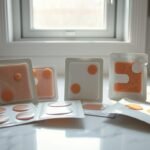
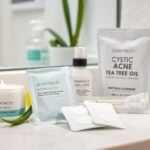
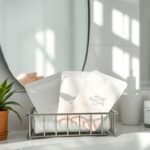
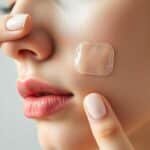
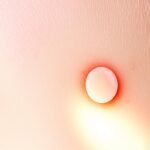
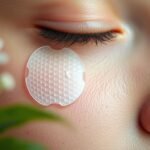
Interesting read, but isnt it possible that diet plays a bigger role in hormonal acne than these patches? Just a thought.
Interesting read, but arent we just treating symptoms with patches? Isnt a holistic diet/lifestyle change a better long-term solution?
Interesting read, but have we considered diet changes over patches? Isnt hormonal balance more about what we eat and less about skin applications?
Does anyone else think hormonal acne is more about diet and stress? Patches seem like just a temporary band-aid fix. Thoughts?
Interesting read, but dont patches just cover the problem? Wouldnt it be better to tackle hormonal imbalances directly? Thoughts?
Just read the article. But really, are hormonal acne patches any better than diet control and regular exercise? Just asking!
Interesting read, but isnt it better to address the root cause of hormonal imbalance rather than just patching up the symptoms?
Interesting read, but are we just ignoring potential side effects of these patches? Isnt a holistic approach better for our bodies?
Interesting read, but arent patches just a temporary fix? Shouldnt we focus more on regulating hormones naturally? Just a thought!
Interesting read, but arent we just treating symptoms with patches? What about addressing root cause like diet and stress? Just a thought.
I get hormonal acne too, but do we really need patches? Cant diet and lifestyle changes address the root cause? Just a thought.
Interesting read, but what about diets role in hormonal acne? Arent we overlooking the impact of sugar and dairy here?
Interesting article, but isnt it high time we put more focus on natural remedies, instead of relying on these chemical patches? Just a thought.
Interesting read, but isnt diet a major factor in hormonal acne? Also, arent patches just a band-aid solution, not a real cure?